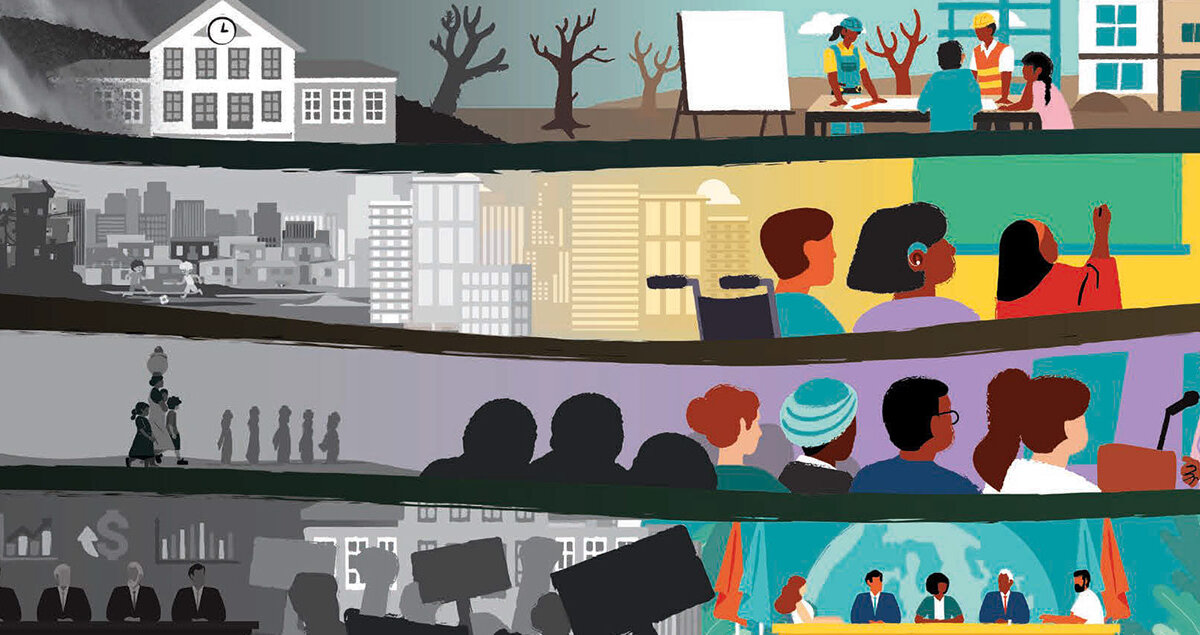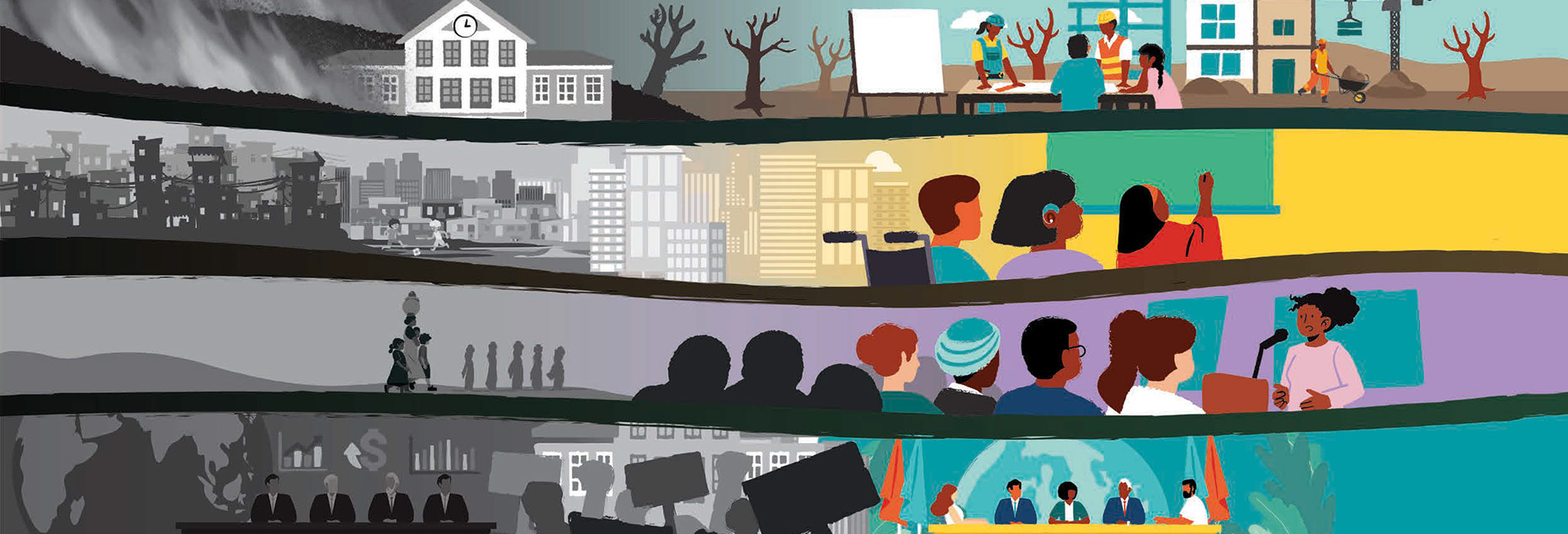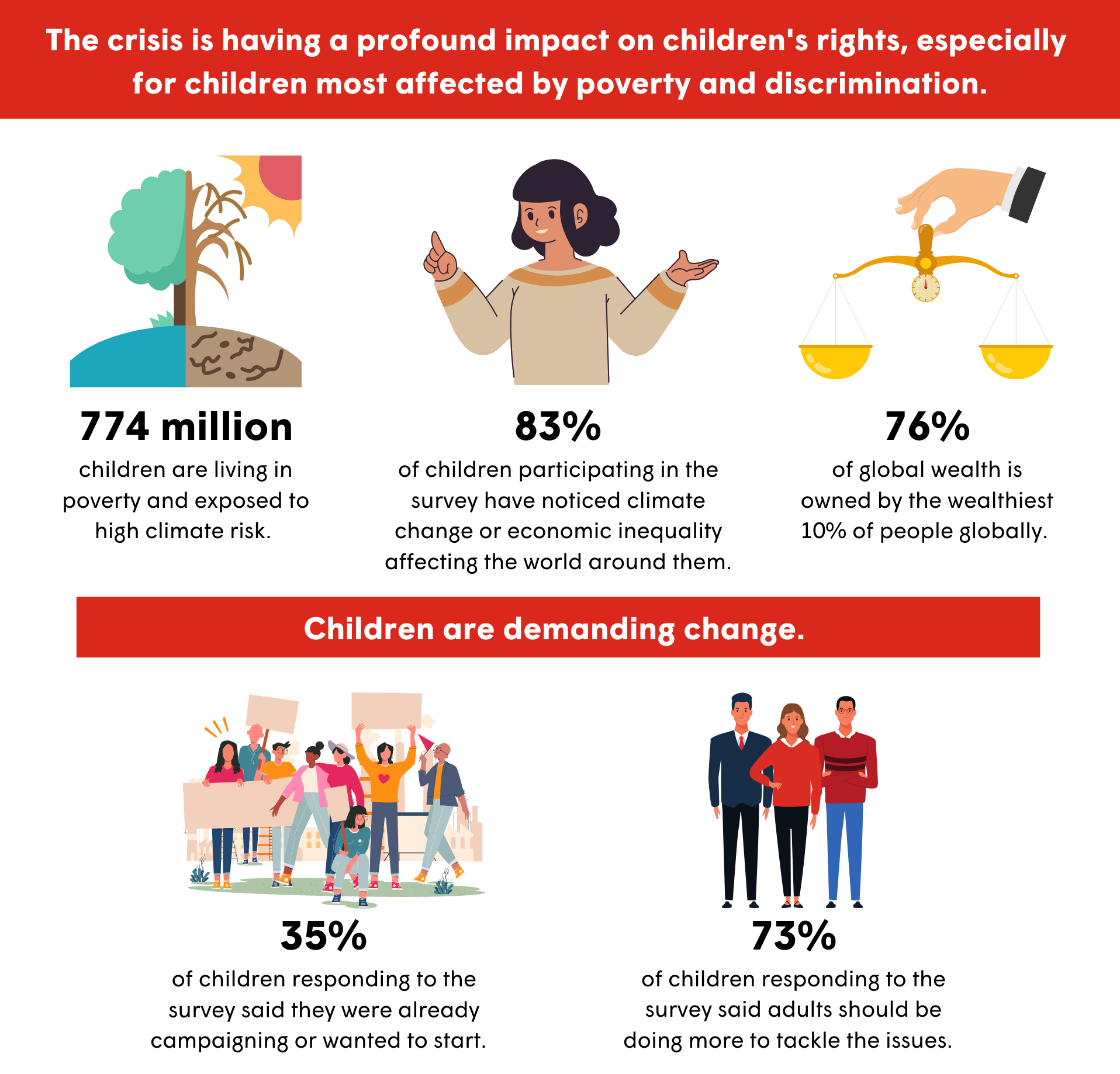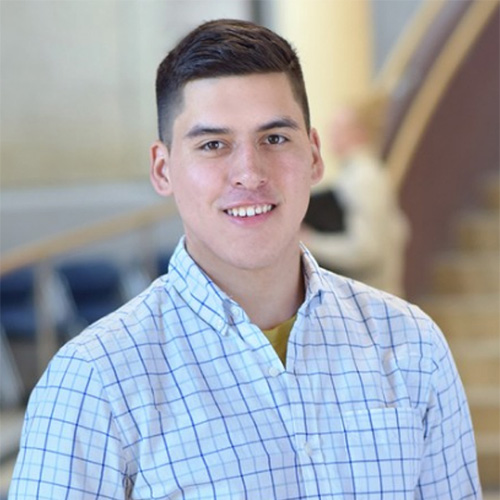

RAISING GENERATION HOPE
The stakes of the climate crisis are too high for the world’s youth.
Their voices need to be heard now.
Something is menacing the planet’s children and they know it. In 2022, humanitarian emergencies around the world—armed conflict, natural disasters, forced migration or displacement, poverty, and hunger—have continued to put children’s lives at risk. In Pakistan, devastating floods swallowed communities whole and destroyed two million homes, impacting 33 million people. In Somalia, severe droughts have ravaged the country, leaving 1.5 million children malnourished, impacting their health and development at a critical age. In Ukraine, the ongoing conflict has caused global food prices to rise, further exacerbating food insecurity for those living in poverty. Right here in Canada, heatwave-induced wildfires have consumed the homes of Indigenous youth and disproportionately threaten their communities.
The destructive force that devours so much must seem like a monster from children’s nightmares. But unlike a fearsome creature lurking under beds that adults can assure children is only a figment of their imagination, this monster is real—and hundreds of millions of children already know it all too well. As one fifteen-year-old Colombian girl quoted in the Save the Children’s Generation Hope report, which surveyed 54,000 children across forty-one countries—puts it: “Climate change is like a monster that destroys.”
According to a previous Save the Children report, “Born into the Climate Crisis,” compared to someone born in 1960, a child born in 2020 is likely to experience twice as many wildfires, 2.6 times as many droughts, 2.8 times as many river floods, and 6.8 times as many heatwaves. Eighty percent of children are affected by at least one extreme climate event a year. As humanitarian emergencies across the globe continue to put children’s lives at risk it’s become clear that climate change is the source of the resulting inequalities. It is the reason their homes have been flooded or burned, that their food has become inaccessible or unaffordable.
“Most children are now seeing the effects of climate change up close,” says Danny Glenwright, President and CEO of Save the Children. As children directly experience the impact of wildfires, floods, hurricanes, and heatwaves on their lives, any doubt as to what is to blame has disappeared. “For this generation, there’s no longer a debate about whether climate change is behind so many of these tragedies that are impacting us,” Glenwright says.
That’s produced some frustration amongst those who do doubt it and don’t see—as one in two children do—that global weather is getting worse due to climate change. Children are also critical of many factors cited as obstacles to effectively tackling climate-related crises, from governmental corruption and public indifference to sluggish policy change and inadequate corporate responsibility. A simple plea by a fifteen-year-old boy in Sierra Leone speaks volumes: “I want leaders to stop taking bribes.” While a child in the United Kingdom offers a tidy summation of where the blame lies: “I think it’s more the responsibilities of companies and the government.”
Despite the current escalation of extreme weather and the fear of the Earth reaching a perilous point of no return, the world’s youth don’t despair. Far from it. “We call this ‘generation hope’ for a reason,” says Glenwright. “They’re hopeful that adults can change things and do something to head off the very worst effects of climate change.” They are not, however, happy to allow only adults to determine their future or the planet’s.
The Climate and Inequality Crisis in Numbers

Children are the inheritors of the Earth. They have a deep personal investment in the long-term impacts of climate change. They are the ones who will live with the consequences if little or nothing is done. The stakes for them are high, and yet they are not afforded proportional agency to do something about it. “They don’t often have the ability to express their views in meaningful ways,” says Glenwright. Their views can still be dismissed as uninformed or inexperienced. As a young woman from the Indigenous Sámi community in Norway told STC: “We meet a lot of resistance in pretty much everything we do or say.” A twelve-year-old Nigerian boy echoes that: “We try to tell adults things about us and how the community is affecting us, but they don’t listen to us because we are small.”
They should, however, be listened to. “Their views are sophisticated, nuanced, intelligent, and they have a clear understanding of the challenges that all of us adults are grappling with,” says Glenwright. Dakota Norris, a member of the Gwich’in Nation and coordinator for the Northern and Indigenous Sustainable Energy Initiatives Master of Environment and Sustainability student, has seen this firsthand with Indigenous youth. “Their experience can really help us shape our plans and strategies,” he says. “I’ve worked with them to create their own declarations that state their vision for the future to help decision-makers be accountable and acknowledge their own role in climate action.”
The world has seen that through high-profile activists like Greta Thunberg, Haven Coleman, Leah Namugerwa, and others raising awareness and challenging institutions. But more young climate activists need a platform. Thirty-five percent of children surveyed for the “Generation Hope” report said they were already campaigning for change in their communities and countries or were about to. “We should be creating more opportunities for them to share their perspectives and take part in some of the solutions,” says Glenwright.
He sees it as Save the Children’s responsibility to commit to providing those opportunities by giving them both metaphorical and literal megaphones to directly address the impacts of climate change. It’s why STC’s “Generation Hope” report aspired to give voice to 54,000 children, why at the 2022 United Nations Climate Change Conference it helped support the involvement of numerous youth advocates, and why its Shift For Our Planet initiative supports young changemakers in efforts to challenge climate change and the humanitarian emergencies it causes.
The economic upheaval caused by the COVID-19 pandemic and the conflict in Ukraine has directly impacted global food costs and international logistics, worsening inequalities for hundreds of millions of people around the world. But this crisis of inequality has its roots in climate change—pandemics and war are just shocks to the system—and as always, children are the ones who will most immediately pay the price. The seriousness of climate-related disasters continues to call for every child’s experience, perspective, and voice to be heard. Glenwright encourages children not to be afraid to push for further change. “Don’t be scared to raise your voice. Don’t be scared to push to take a seat at the table and remind the adults in your life that your voice matters,” he says. Save the Children is listening. The world and its leaders must listen too.
Hope at Home

It can be too easy for Canadians to think of climate-related emergencies as problems that always happen somewhere else. In truth, these events are happening with increasing frequency here too—and impacting one population more than any other. “Indigenous communities are the frontline of climate change. They are the first and often the most impacted,” says Dakota Norris, coordinator for the Northern and Indigenous Sustainable Energy Initiatives Master of Environment and Sustainability student, who has worked with Indigenous youth to create climate action plans through organizations like Youth Climate Lab. Norris works in partnership with Indigenous communities and has also collaborated with Save the Children’s National Reconciliation Program on climate change projects.
Around the Arctic, which is warming two to three times faster than the rest of Canada, melting permafrost is damaging critical infrastructure and threatening livelihoods. On the coasts and rivers, landslides and erosion threaten homes and businesses, displacing populations and forcing relocation. Across the country, wildfires disproportionately impact Indigenous communities, destroying towns and dispersing groups from traditional lands. The ability to hunt, fish, gather, and simply live undisturbed is becoming more of a challenge as the climate becomes more unpredictable.
Here too, children’s voices can be a powerful force for change. “Youth are not only a great source of insight because of their experiences and voice, but they provide a lot of hope,” says Norris. “They bring a broad understanding to what’s possible for the future.”
FOR MORE INFORMATION, PLEASE VISIT SAVE THE CHILDREN CANADA.







